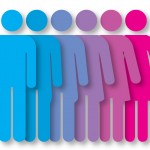What is a Gender Spectrum?

By Lillie Mucha
The difference between gender as a spectrum versus as a binary construct is one that is very close to me. I’ve known for several years that I don’t fall perfectly into the category of a “stereotypical female,” and I suspect that nearly every girl feels the same way. Virginia Valian in “Women at the Top in Science – and Elsewhere” brings to light the harmful effects of establishing male and female stereotypes – “gender schemas” – that attempt to polarize these two groups of humans.
The Spectrum vs. the Binary
Schemas are of course necessary for social interaction to occur productively, since they can be highly useful in understanding a situation in the world. It would be very difficult to operate in the world if one didn’t have an understanding of the schematic differences between a fifteen-year-old and a fifty-year-old person. However, in the case of gender, people cannot be categorized so neatly.
The first thing to understand is that gender is not equal to sex. An individual’s sex is determined by their genitalia, and they can be male, female, or intersex, and with modern surgery can change their private parts to match their gender. Having any type of sexual organ does not automatically place a person’s gender, which is why communities of transgender gender people exist.
While it is a step in the right direction to understand that people are not 100% female and 100% male, this still gives the false impression of a binary gender system, in which men and women are judged based on their displacement from the average man and average woman.
There is no average man. There is no average woman.
These fictional people have been produced from the media, social norms, historical representations, personal encounters, and every other human influence. If we were to pretend for a minute that they never did exist, then it would become obvious that the range of human identities is of a much larger scope than the two standards we see so often today.
Gender and Science
There is a misconception about the science fields that I myself had to overcome. I thought of science as an alien world, completely separate from every other profession. Many people believe in the “mad scientist” stereotype, thinking that only exceptionally gifted people can become scientists. In only a few months of exposure to science at college, it became clear to me that people who work in science are not gods at all, but authentic human beings.
When the gender stereotype and the scientist stereotype collide, society finds situations in which women have to prove themselves worthy, and, consciously or unconsciously, others might build assumptions about their abilities even with solid proof in front of them. It’s important to have a good understanding of what a nonbinary gender spectrum is. Sex, the biological determinant of our bodies, unless otherwise altered, does not equate with gender, and – as said by Valian – “[the genders] overlap.” A female-sex person can have a personality just as scientifically inclined as that of a male-sex person.
The Next Step: Fixing the Problem
Valian says in the final paragraph that gender stereotypes will be “eventually dispelled by education.” I believe the same. It is critical to the success of the feminist movement at large, and especially concerning the underrepresentation of women in science-related fields, to teach the general population why men and women are more alike than we are different.
Image source: link